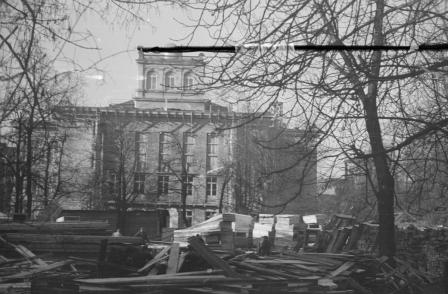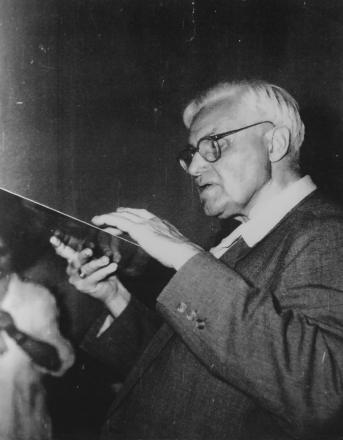Post-war period
After the end of the war, in 1945, the Warsaw University of Technology resumed its activity in Warsaw (in 1944 the Warsaw University of Technology in Lublin was reactivated). In 1946, classes in physics began. The Physics Building was rebuilt, it was seriously damaged during the Warsaw Uprising.
Professor Szczepan Szczeniowski writes about this period in his book "150 years of higher technical education in Warsaw" (WPW, Warsaw 1979):
At that time, new departments were established at the Polytechnic. On September 1, 1946, the new Chair of Radiology at the Faculty of Electrical Engineering was taken over by professor Cezary Pawłowski (former student of Maria Skłodowska-Curie), who vigorously dealt with the reconstruction of the Building of Physics, and on October 21, 1947 Witold Majewski became an associate professor of electronics (from 1951, electron physics) ) at the Faculty of Electrical Engineering (from October 1951 at the Department of Communications). The chair after prof. Kalinowski, who died on March 27, 1946, initially took over as associate professor Józef Roliński (in 1954 prof. Wolfke from April 1948 as full professor Wacław Szymanowski. When in 1951 the Engineering School of Wawelberg and Rotwand with the University of Technology, Professor F. Zienkowski was retired (for political reasons), and the School's Physics Department was formally incorporated into the Department of Communications as the Department of General Physics. The chair was not filled until September 1, 1957, when full professor Szczepan Szczeniowski became its head.
On the initiative of prof. Szymanowski was organized in 1949 - in the premises of the Department of Physics, Faculty of Electrical Engineering and the Department of Radiology - departmental Central Institute of Technical Physics (GIFT). Prof. Szymanowski secured additional credits for equipping GIFT with instruments. The main part of the rooms was taken over by prof. Ignacy Malecki, who moved to Warsaw from Gdańsk and organized the Electroacoustics Department. Prof. Leonard Sosnowski from the University of Warsaw, who, however, resigned after a few months. They were taken over by prof. Mieczysław Jeżewski after moving from Krakow to Warsaw. Besides, two other physicists worked at GIFT: prof. W. Majewski and deputy prof. Witold Łaniecki, and spectrography was dealt with by Dr. Stanisław Kaliński transferred from Gliwice.
The initiative of prof. Szymanowski, although correct in principle, turned out to be premature. After less than two years of existence, GIFT collapsed and its property was taken over in the main part of the department: Electroacoustics (prof. Malecki) and Telecommunication Structures and Radio Broadcasting (deputy prof. Antoni Kiliński). Some of the instruments were taken over by the Department of Physics, but the rooms did not return to their home departments. In 1957, at the request of prof. Szczeniowski, the departments of physics at the Warsaw University of Technology were reorganized: the Department of Physics of the Faculty of Electrical Engineering was renamed the Department of Physics "A", and the departments of the departments of Communications and Chemistry into the departments of Physics "B" and Physics "C". In addition, the Department of Physics "D" was created, supporting the mechanical departments in the southern area of the Polytechnic: its head was prof. the so-called W. Ścisłowski. In 1963, the Department of Electron Physics was incorporated into the Department of Physics "B". After retirement, prof. Roliński, on September 30, 1960 prof. the so-called Józef Hurwic, and after the death of prof. Szymanowskiego On January 16, 1965, the management of the Department of Physics "A" was taken by doc. Bogna Klarner.
The above-mentioned departments carried out the following didactic and scientific tasks:
- Department "A" provided didactic services to the following faculties: Electrical, Civil Engineering, Sanitary and Water Engineering, Geodesy and Cartography. The main subject of scientific work was comprehensive research (from basic research through material technology to the construction of prototypes of xerographic devices) on electrophotographic processes, which was initiated under the supervision of prof. Szymanowski as early as the early 1950s. That is why Professor Szymanowski is considered to be the "father" of Polish xerography.
- Department "B" provided didactic services for the Faculty of Electronics and the Faculty of Mechanical Engineering, Energy and Aviation. It should be emphasized that in those years at the Faculty of Electronics, the number of hours devoted to physics in the curriculum was over 600. The department conducted (under the supervision of Prof. Szczeniowski) basic research on the phenomena of ferromagnetism, phase transformations and the structure of materials. The properties of materials under high pressures were also tested. In 1963, the previously independently existing Department of Electron Physics was incorporated into the "B" chair.
- Department "C" provided didactic services to the Faculty of Chemistry. The main direction of scientific activity was basic research in molecular physics.
- Department "D" provided didactic services to the Faculties of Mechanical Engineering, Automobiles and Working Machines, and Precision Mechanics. The main research area of the department was the phenomena of transport in alkalihaloids (under the supervision of prof. W. Ścisłowski).






